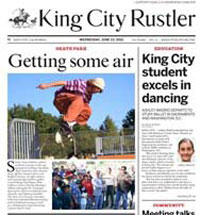KING CITY — Board members from King City Union School District discussed the 2020-21 school year budget and math curriculum contracts during their June 30 special board meeting, but a decision on how to reopen schools in August was tabled to this week after lengthy discussion and numerous concerns brought forth during public comment.
The board evaluated a written report about how the district responded to the Covid-19 pandemic during the latest 2019-20 school year.
“The availability of Wi-Fi was a significant challenge for many of our families that prohibited them from being able to participate in online learning,” said Rory Livingston, district superintendent. “We were required to continue with the learning packets while we continued to resolve the online piece.”
The district’s ability to keep food service going through the entire closure period was highlighted as well.
The upcoming academic year’s budget was less clearly defined than the after-status report on Covid-19 response, since the information from Sacramento has shifted multiple times.
“This is a make-believe budget,” Livingston said. “I’m asking you to approve a budget knowing from a revenue perspective, it’s inaccurate. From an expenditure perspective, it is accurate.”
Although budget numbers were shifted by the state in late June, Livingston made no mention of budgetary shortfalls for the district. He noted that if the state failed to provide their end of finances as budgeted, the state would be the entity responsible for providing the district with money, and would not end up with the district going into fiscal insolvency.
Livingston explained the plan in the agenda included three models of what could be done to reopen with either a traditional instruction model, a distance learning model or a hybrid model.
“We’ve had a task force working on it since the last week in April,” Livingston said about the process of putting together a guidance document.
He explained the state had already said reopening would be up to local decisions for California school districts, with their having an ability to pick and choose from their reopening models.
“On that basis, the task force worked hard and came together on several meetings and came up with this plan, and it’s a good general plan,” Livingston said.
He noted the plan was left general due to a lack of staff hours to put together a detailed plan that went into heavy detail. He recommended embracing the plan as a general document.
As far as direction from the state, Livingston expressed frustration with seeking guidance from Sacramento.
“It changes every time there’s a press conference,” he said. “… If our number one concern is student learning, we have to pick the model that’s best for student learning as it applies to the city.”
Numerous public comments held student safety in higher regard and maintaining a learning environment. Others commented on staff safety. Overall, enforcement of safety protocols and risk of spreading Covid-19 were a high concern.
Livingston reviewed the idea of going to a fully distance learning model, noting the home situations of students based on surveys conducted by school sites, which estimate 70 to 75 percent of the families have no parent at home during the day.
“If you’re going to do distance learning, especially for younger age students, you need a significant adult presence to assist the child, working through the computer and providing some kind of guidance,” Livingston said.
An additional component of a hybrid model would include more computer equipment to ensure students wouldn’t have to haul laptops back and forth between school and home, as a measure to reduce infection.
Livingston explained the district has 2,600 Chromebooks, but would need at least 50 percent more to ensure dedicated home laptops for students. Overall, he said the district is looking at buying an additional 2,000 Chromebooks in the event of a hybrid educational model, all with wireless chips in them to solve the issue of internet access. Such a purchase would amount to $1.5 million, he said.
A lengthy discussion followed the introduction of a math curriculum with faculty training, with commenting teachers and board members having mixed feelings about the efficacy of the particular math program and the employees sent by the program to train teachers how to implement the program, which came to a contracted cost of $90,000.
“I’m tired of the monkeying around with curriculum,” said Board Member Lawrence Hinkle. “I’d like them to stick with something and stay with it, and I think we’ve got something that’s working, and I’d like to see it through.”
Board President Susan King brought up the idea of having senior teachers mentor junior teachers in curriculum implementation.
“I think starting now we need to rely on our own faculty more and more,” said Board Member Mildred Dodd. “They have proven they will step up when requested and they have done an excellent job.”
The math contract passed in a 3-2 vote, with Board Member Vina Paramo expressing her reluctance at the faculty training provided by the company, but approving for those junior teachers who need and desired the instruction.
Dodd noted those who have strong concerns for how the district is managed should consider running for school board.
The board will revisit the issue of schools reopening during its July 15 meeting.















